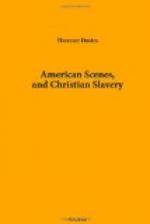At 8 o’clock in the morning of the 8th of March I left Lane Seminary, with a heavy heart at the thought that in all probability I should never see it again. There was a sharp frost. Dr. Stowe accompanied me to the omnibus. “All right!”—“Pax vobiscum!”—the vehicle moved on, and directly the Doctor was at a distance of a hundred yards waving a farewell. It was the last look.
At 11 A.M. myself, wife, baggage,—all were setting off from the “Queen City” for Pittsburgh, a distance of 496 miles, in the Clipper No. 2, a fine boat, and in good hands.
LETTER XXII.
Cincinnati—Its History and Progress—Its Trade and Commerce—Its Periodical Press—Its Church Accommodation—Its Future Prospects —Steaming up the Ohio—Contrast between Freedom and Slavery—An Indian Mound—Splendid Scenery—Coal Hills.
Before proceeding with our trip to Pittsburg, I will bring together all the material points of information I have gathered relative to Cincinnati.
1. Its History and Progress.—The first year of the present century found here but 750 inhabitants. In 1810 there were 2,540; in 1820, 9,602; in 1830, 24,381; in 1840, 46,382. At present the population is estimated at 80,000. The coloured population forms one twenty-fifth, or 4 per cent., of the whole. The native Europeans form one-fifth of the white population.
2. Its Trade and Commerce.—The principal trade is in pork. Hence the nickname of Porkapolis. The yearly value of pork packed and exported is about five millions of dollars, or one million of guineas! As a proof of the amazing activity which characterizes all the details of cutting, curing, packing, &c., I have been credibly informed that two men, in one of the pork-houses, cut up in less than thirteen hours 850 hogs, averaging 300 lbs. each,—two others placing them on the block for the purpose. All these hogs were weighed singly on scales in the course of eleven hours. Another hand trimmed the hams, 1,700 pieces, in “Cincinnati style,” as fast as they were separated from the carcases. The hogs were thus cut up and disposed of at the rate of more than one per minute! And this, I was told, was not much beyond the ordinary day’s work at the pork-houses.
Steam-boat building is another important branch of trade in this place.
DOLLARS. In 1840 there were built here 33 boats of 15,341 tons, costing 592,600 1844 " " 37 " 7,838 " 542,500 1845 " " 27 " 6,609 " 506,500
3. Its Periodical Press.—There are sixteen daily papers! Of these, thirteen issue also a weekly number. Besides these, there are seventeen weekly papers unconnected with daily issues. But Cincinnati is liberal in her patronage of eastern publications. During the year 1845 one house, that of Robinson and Jones, the principal periodical depot in the city, and through which the great body of the people are supplied with this sort of literature, sold of




